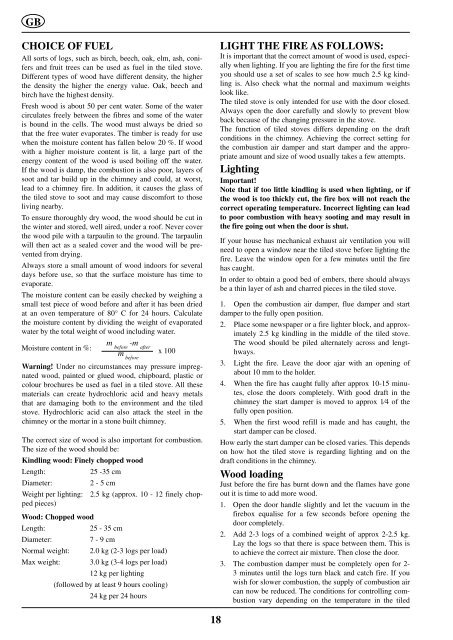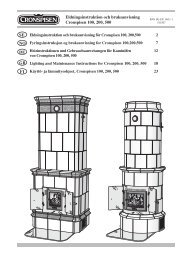Eldningsinstruktion och bruksanvisning Cronspisen 100, 200, 500 ...
Eldningsinstruktion och bruksanvisning Cronspisen 100, 200, 500 ...
Eldningsinstruktion och bruksanvisning Cronspisen 100, 200, 500 ...
Create successful ePaper yourself
Turn your PDF publications into a flip-book with our unique Google optimized e-Paper software.
GB<br />
CHOICE OF FUEL<br />
All sorts of logs, such as birch, beech, oak, elm, ash, conifers<br />
and fruit trees can be used as fuel in the tiled stove.<br />
Different types of wood have different density, the higher<br />
the density the higher the energy value. Oak, beech and<br />
birch have the highest density.<br />
Fresh wood is about 50 per cent water. Some of the water<br />
circulates freely between the fibres and some of the water<br />
is bound in the cells. The wood must always be dried so<br />
that the free water evaporates. The timber is ready for use<br />
when the moisture content has fallen below 20 %. If wood<br />
with a higher moisture content is lit, a large part of the<br />
energy content of the wood is used boiling off the water.<br />
If the wood is damp, the combustion is also poor, layers of<br />
soot and tar build up in the chimney and could, at worst,<br />
lead to a chimney fire. In addition, it causes the glass of<br />
the tiled stove to soot and may cause discomfort to those<br />
living nearby.<br />
To ensure thoroughly dry wood, the wood should be cut in<br />
the winter and stored, well aired, under a roof. Never cover<br />
the wood pile with a tarpaulin to the ground. The tarpaulin<br />
will then act as a sealed cover and the wood will be prevented<br />
from drying.<br />
Always store a small amount of wood indoors for several<br />
days before use, so that the surface moisture has time to<br />
evaporate.<br />
The moisture content can be easily checked by weighing a<br />
small test piece of wood before and after it has been dried<br />
at an oven temperature of 80° C for 24 hours. Calculate<br />
the moisture content by dividing the weight of evaporated<br />
water by the total weight of wood including water.<br />
m -m<br />
Moisture content in %: before after<br />
m x <strong>100</strong><br />
before<br />
Warning! Under no circumstances may pressure impregnated<br />
wood, painted or glued wood, chipboard, plastic or<br />
colour br<strong>och</strong>ures be used as fuel in a tiled stove. All these<br />
materials can create hydr<strong>och</strong>loric acid and heavy metals<br />
that are damaging both to the environment and the tiled<br />
stove. Hydr<strong>och</strong>loric acid can also attack the steel in the<br />
chimney or the mortar in a stone built chimney.<br />
The correct size of wood is also important for combustion.<br />
The size of the wood should be:<br />
Kindling wood: Finely chopped wood<br />
Length: 25 -35 cm<br />
Diameter: 2 - 5 cm<br />
Weight per lighting: 2.5 kg (approx. 10 - 12 finely chopped<br />
pieces)<br />
Wood: Chopped wood<br />
Length: 25 - 35 cm<br />
Diameter: 7 - 9 cm<br />
Normal weight: 2.0 kg (2-3 logs per load)<br />
Max weight: 3.0 kg (3-4 logs per load)<br />
12 kg per lighting<br />
(followed by at least 9 hours cooling)<br />
24 kg per 24 hours<br />
18<br />
LIGHT THE FIRE AS FOLLOWS:<br />
It is important that the correct amount of wood is used, especially<br />
when lighting. If you are lighting the fire for the first time<br />
you should use a set of scales to see how much 2.5 kg kindling<br />
is. Also check what the normal and maximum weights<br />
look like.<br />
The tiled stove is only intended for use with the door closed.<br />
Always open the door carefully and slowly to prevent blow<br />
back because of the changing pressure in the stove.<br />
The function of tiled stoves differs depending on the draft<br />
conditions in the chimney. Achieving the correct setting for<br />
the combustion air damper and start damper and the appropriate<br />
amount and size of wood usually takes a few attempts.<br />
Lighting<br />
Important!<br />
Note that if too little kindling is used when lighting, or if<br />
the wood is too thickly cut, the fire box will not reach the<br />
correct operating temperature. Incorrect lighting can lead<br />
to poor combustion with heavy sooting and may result in<br />
the fire going out when the door is shut.<br />
If your house has mechanical exhaust air ventilation you will<br />
need to open a window near the tiled stove before lighting the<br />
fire. Leave the window open for a few minutes until the fire<br />
has caught.<br />
In order to obtain a good bed of embers, there should always<br />
be a thin layer of ash and charred pieces in the tiled stove.<br />
1. Open the combustion air damper, flue damper and start<br />
damper to the fully open position.<br />
2. Place some newspaper or a fire lighter block, and approximately<br />
2.5 kg kindling in the middle of the tiled stove.<br />
The wood should be piled alternately across and lengthways.<br />
3. Light the fire. Leave the door ajar with an opening of<br />
about 10 mm to the holder.<br />
4. When the fire has caught fully after approx 10-15 minutes,<br />
close the doors completely. With good draft in the<br />
chimney the start damper is moved to approx 1⁄4 of the<br />
fully open position.<br />
5. When the first wood refill is made and has caught, the<br />
start damper can be closed.<br />
How early the start damper can be closed varies. This depends<br />
on how hot the tiled stove is regarding lighting and on the<br />
draft conditions in the chimney.<br />
Wood loading<br />
Just before the fire has burnt down and the flames have gone<br />
out it is time to add more wood.<br />
1. Open the door handle slightly and let the vacuum in the<br />
firebox equalise for a few seconds before opening the<br />
door completely.<br />
2. Add 2-3 logs of a combined weight of approx 2-2.5 kg.<br />
Lay the logs so that there is space between them. This is<br />
to achieve the correct air mixture. Then close the door.<br />
3. The combustion damper must be completely open for 2-<br />
3 minutes until the logs turn black and catch fire. If you<br />
wish for slower combustion, the supply of combustion air<br />
can now be reduced. The conditions for controlling combustion<br />
vary depending on the temperature in the tiled








